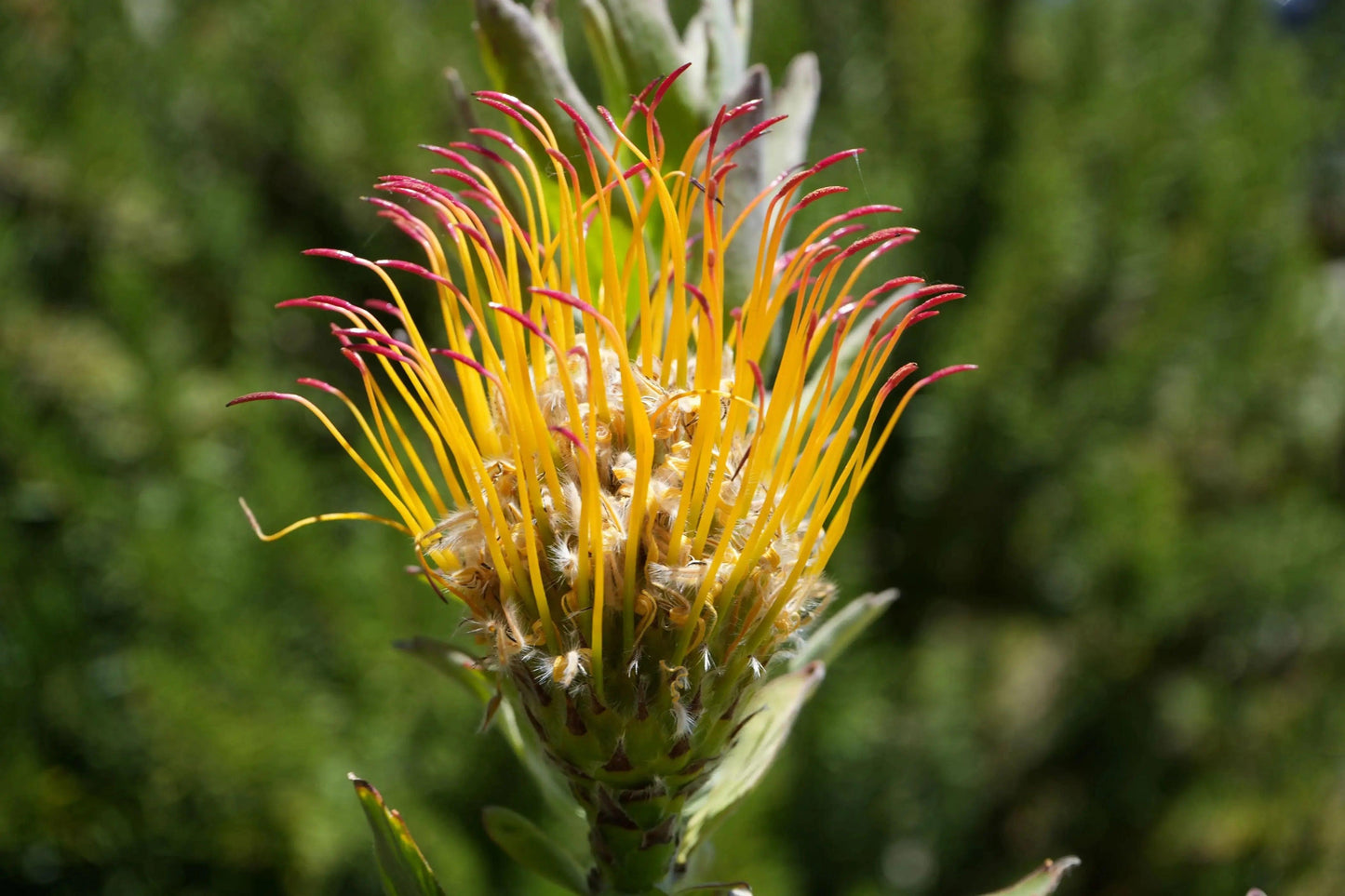Bonte Farm
Leucospermum gueinzii: A Spiky Sensation, Lemon Yellow Pincushion Bush for Coastal Gardens
Leucospermum gueinzii: A Spiky Sensation, Lemon Yellow Pincushion Bush for Coastal Gardens
Couldn't load pickup availability
💛 Leucospermum gueinzii: The Compact Yellow Coastal Pincushion
The Leucospermum gueinzii is a beautiful, naturally occurring species of Pincushion Protea (Leucospermum genus) valued for its compact, rounded habit and clear yellow flowers. This handsome evergreen shrub is an excellent choice for smaller gardens and landscapes, producing abundant, medium-sized, lemon-yellow blooms whose pin-like styles create a soft, radiant effect. L. gueinzii is an exceptional dwarf specimen plant for adding bright color and architectural structure to Mediterranean, coastal, and xeriscape gardens. Its dense form, inherent tolerance to salt spray, and superior drought tolerance make it a resilient and low-maintenance choice, yielding attractive long-lasting cut flowers and providing a rich source of nectar for birds.
Botanical Characteristics
|
Characteristic |
Detail |
|
Scientific Name |
Leucospermum gueinzii (Species) |
|
Common Names |
Gueinzii Pincushion, Coastal Yellow Pincushion. |
|
Growth Habit |
A sturdy, mounding evergreen shrub with a dense, rounded, and naturally bushy, compact habit. |
|
Foliage |
Features leathery, soft green leaves with blunt or toothed tips, densely covering the branches. |
|
Flowers |
Medium, round, distinctive Pincushion flower heads, typically 3–4 inches in diameter. Color is a clear, luminous lemon-yellow to soft yellow. |
|
Flowering Season |
Known for a reliable bloom period, typically flowering heavily from late winter through spring, providing essential cool-season brightness. |
|
Coastal Tolerance |
Good resistance to wind and salt spray, making it highly suitable for coastal environments. |
Mature Size
Leucospermum gueinzii maintains a manageable, neat size, suitable for many garden spaces.
- Height: Typically reaches 3–5 feet (0.9–1.5 meters) tall.
- Spread: Achieves a dense, manageable spread of 4–5 feet (1.2–1.5 meters) wide.
- Its compact size is a key feature for restricted spaces and containers.
USDA Hardiness Zone
This Leucospermum species is best suited for USDA Hardiness Zones 9–11. It thrives in mild, coastal, and Mediterranean climates where it receives full sun. It is intolerant of sustained freezing temperatures.
Cultivation and Care
|
Aspect |
Care Instructions |
|
Sunlight |
Requires full sun (a minimum of 6 hours of direct sun daily) and excellent air circulation to ensure strong growth and maximum bloom production. |
|
Soil |
Essential: Demands perfectly well-drained, acidic soil (pH 5.0–6.0). Thrives in sandy, gritty, low-nutrient soils and must not sit in heavy, wet clay. |
|
Water |
Highly drought-tolerant once established. Water deeply during the first year. Mature plants require minimal summer water; overwatering is the primary threat. |
|
Fertilizer |
Crucial: ABSOLUTELY AVOID all phosphorus fertilizers. Proteaceae are extremely phosphorus-sensitive. Use a specialized, low-phosphorus formula or skip fertilizing entirely. |
|
Pruning |
Mandatory: The best pruning is achieved by harvesting the flowers heavily deep into the bush. This encourages new growth from the base and maintains a dense, productive shape. |
Landscape Use
- Specimen Plant: Used as a highly colorful, central focal point due to its bright, clear color.
- Informal Hedge: Its density and size are suitable for creating a low flowering hedge or border.
- Coastal Gardens: Excellent choice for salt-tolerant landscapes near the ocean.
- Xeriscape Design: A cornerstone, low-water, low-fertility plant for arid landscapes.
Wildlife Attraction
The distinctive flower heads produce a generous amount of sweet nectar, making them extremely attractive to nectar-feeding birds, which serve as the primary pollinators.1 Planting L. gueinzii is an excellent way to invite hummingbirds and native birds into the cool-season garden.
Pest and Disease Resistance
Leucospermum gueinzii is generally a hardy and robust plant when its crucial drainage needs are met.2 The most common issues are root rot and collar rot, which are caused by poor soil drainage or overwatering—this is the single most critical factor to avoid.
Propagation
To ensure the resulting plant maintains the specific, desirable traits, compact habit, and clear yellow color of this species, propagation can be achieved using semi-hardwood cuttings, which are generally taken during the warmer months. While seeds are viable, cuttings guarantee the desired genetic traits.
Share







FAQs
Got a question? We are here to answer







